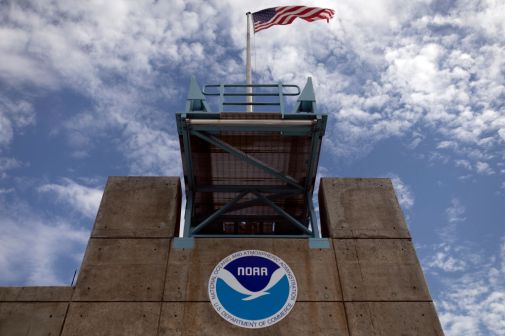Tech titans ready their clouds for NOAA weather data

(iStockphoto)
Update (4/22/15, 11:19 am): Included more information on IBM’s role in collaboration.
It’s fitting that the 20 terabytes of data the National Oceanic and Atmospheric Administration produces every day will now live in the cloud.
The Commerce Department took a step Tuesday to make NOAA data more accessible as Commerce Secretary Penny Pritzker announced a collaboration among some of the country’s top tech companies to give the public a range of environmental, weather and climate data to access and explore.
Amazon Web Services, Google, IBM, Microsoft and the Open Cloud Consortium have entered into a cooperative research and development agreement with the Commerce Department that will push NOAA data into the companies’ respective cloud platforms to increase the quantity of and speed at which the data becomes publicly available.
“The Commerce Department’s data collection literally reaches from the depths of the ocean to the surface of the sun,” Pritzker said during a Monday keynote address at the American Meteorological Society’s Washington Forum. “This announcement is another example of our ongoing commitment to providing a broad foundation for economic growth and opportunity to America’s businesses by transforming the department’s data capabilities and supporting a data-enabled economy.”
According to Commerce, the data used could come from a variety of sources: Doppler radar, weather satellites, buoy networks, tide gauges, and ships and aircraft. Commerce expects this data to launch new products and services that could benefit consumer goods, transportation, health care and energy utilities.
“Ease of access to the wealth of climate, weather, and environmental data NOAA is making available will have an enormous impact on researchers across many disciplines,” Robert Grossman, director of the Open Cloud Consortium, said in a statement. “The purpose of the Open Cloud Consortium (OCC) collaboration with the NOAA is to make finding and accessing this data easier for the academic, non-profit, and research communities, to enable scientific analysis and to drive discovery.”
A couple of the companies involved have already highlighted what they plan do with the data and how other companies can benefit. AccuWeather plans to use the NOAA data stored on Microsoft’s Azure cloud to increase its speed while also using Microsoft’s predictive analytics to enhance the accuracy of its weather forecasts.
“We believe that opening the door to one of the world’s most valued data resources through Azure Government will speed the rate of innovation and create new insights that will positively affect the lives of millions, so we are enthusiastic about inviting government and private industry to tap into the immense value of NOAA’s data,” Chris Niehaus, Microsoft’s senior director of National Cloud Programs, wrote in a blog post.
Amazon Web Services will partner with The Weather Company, ESRI and big data visualization platform PlanetOS to “look for ways to push more of NOAA’s data to the cloud, with a focus on spurring innovation,” but did not have any further details on what that partnership would entail.
“The data NOAA already makes available to the public drives critical research efforts and multi-billion dollar industries,” Jeff Barr, Amazon Web Services’ chief evangelist, wrote in a blog post. “We anticipate that making more of NOAA’s data widely available will drive even more economic value and social good.”
IBM will also partner with The Weather Company to improve to real-time weather insights.
“As part of the CRADA, IBM can help NOAA publish this data with almost no latency,” wrote Anne Altman, IBM’s General Manager for U.S. Federal. “The faster IBM, and in turn, The Weather Company and others can access that data, the more value that can be generated for those with a need to consume it and act upon it.”
David McClure Jr., a data asset portfolio analyst for NOAA, hinted at this partnership in November when he said the administration “would do more if we were empowered (and had the resources) to do more.”
“We’re trying to focus on a positive mosaic effect – to discover relationships in the data and pull those together and extract economic value,” McClure said at an Armed Forces Communications and Electronics Association Bethesda event on enterprise. “We know the data has value and the private sector thinks it has value, but there’s a cost barrier.”
In November, McClure said such a partnership would be supported by and accessible to the public through the use of access fees, similar to how national parks charge admission. In today’s announcement, there was no mention of any fees needed to access the forthcoming data.






